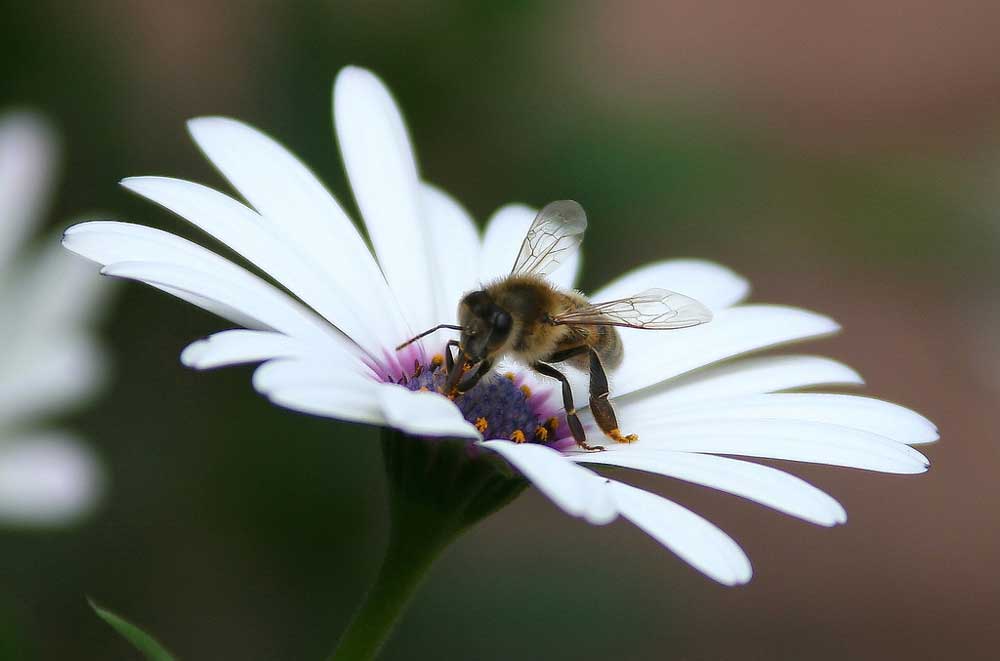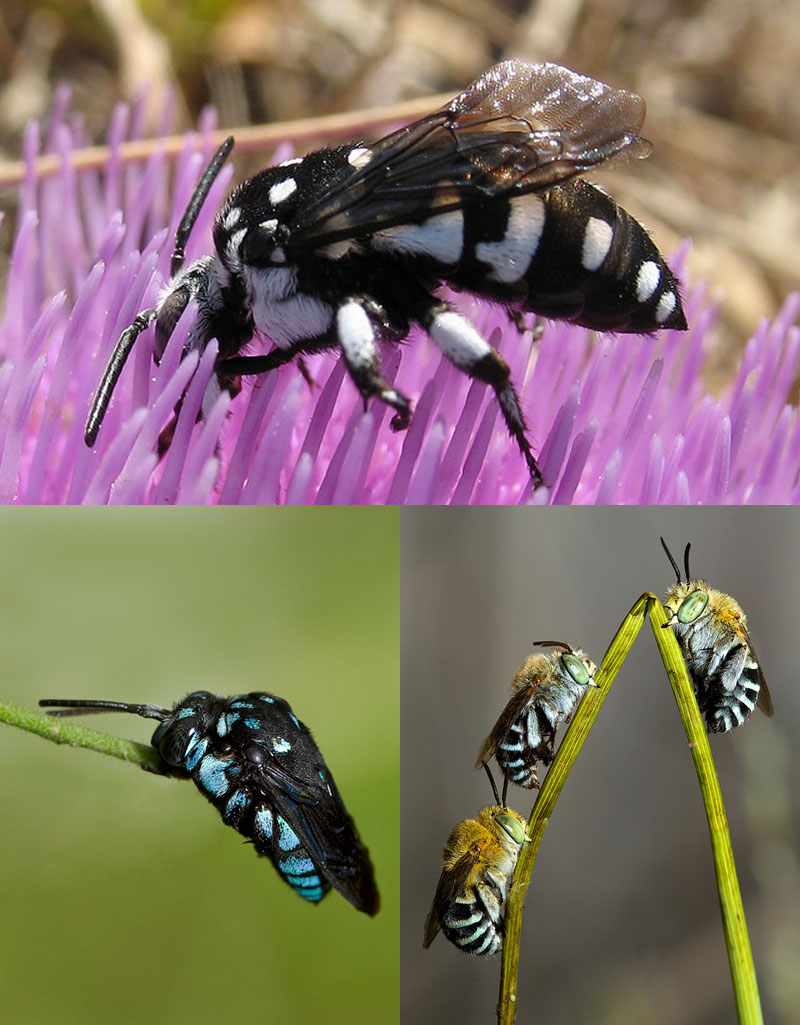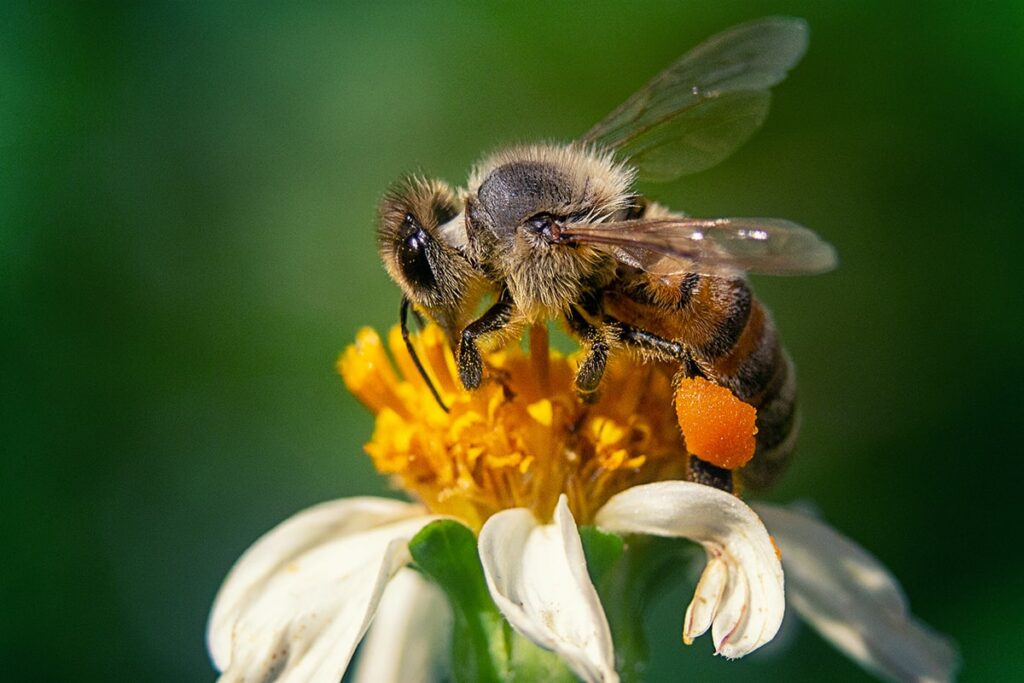- Species: There are around 20,000 known bee species in the world. The honeybee (Apis) is one species with 44 subspecies
- Human food: Honey bees are the only insect that produces food that is eaten by humans
- Overexertion: 3 – 6 weeks after their first wing beat, the average honeybee has worked itself to death and literally dies from overexertion
- Honey: While you might think that bees can make honey from the moment they hatch, this is not the case; they have to learn from older bees
- Winter: In cold climates, honeybees stop flying when the temperature is around 10 degrees and instead congregate inside the hive, forming a large cluster around the queen. They move their wings, creating a temperature of 27 degrees at the start of winter and 34 degrees when the queen starts laying eggs. The bees also rotate in and out of the cluster alternately, so no one gets too cold
- Stinger: The honeybee differs from the other bee species in 3 main ways: 1) it has barbs on its stinger, 2) the stinger detaches and leaves a deadly hole in the bee’s abdomen and 3) the stinger has its own musculature and venom sac that continues to inject venom once the stinger is inserted into the victim
- Heat: Although stinging is the honeybee’s primary defense mechanism, they can also kill larger insects (such as the Asian giant goat hamster) using heat and carbon dioxide. To do this, the bees swarm and form a ball around the large insect. In the center of the sphere, the temperature and carbon dioxide levels rise to such an extent that the insect dies
- Honeybee family: A honeybee family consists of 3 types of bees: workers, drones and the queen. There is usually only one queen, a few hundred workers and up to 80,000 worker bees. All worker bees are female and all drones are male
- Division of labor: The tasks of worker bees are determined by their age. They can act as 1) caterpillar caretakers, cleaners and queen rearing, 2) builders, 3) soldiers and warehouse workers, and 4) collectors. The division of labor is controlled by a juvenile hormone that is used to regulate the bees’ work functions when necessary. The drones’ only job is to fertilize the queen
- Cannibalism: Although bees feed on nectar and car larvae on pollen, bees will eat their fellow bees when food is scarce. From an evolutionary point of view, this also makes sense because it reduces the need for food. Bees start by eating the larvae and eggs to maintain the adult population that can contribute to foraging – but when food is truly limited, the adult bees will also eat each other

Fact: Honey bees can see ultraviolet light, which is especially found around the center of the flower, where there is typically a high concentration of pollen and nectar
More facts about bees
- Recognition: Honeybees can recognize lines, dots, patterns, shapes – and even faces! They do this in the same way as humans. So it’s probably not without reason if you’ve ever felt stalked by a bee…
- Pairing: The mating rituals of bees are gruesome; the male bees – or drones – whose sole purpose in life is to fertilize the queen, die immediately after mating because their endophallus remains inside the queen (which helps ensure fertilization), creating a large hole in their abdomen. Injured drones that survive mating are thrown out of the nest because they are worn out and useless
- Fake male bees: Among bees, males are generally always haploid in all cells – i.e. their chromosome number is 23. However, some male bees are diploid – i.e. with a chromosome number of 46 – making them so-called “false male bees”. Diploid males are typically eliminated shortly after the worker bees hatch
- Sight: Honeybees have 5 eyes. However, having so many eyes doesn’t make their vision much better than many other animals. Bees can, however, see ultraviolet light, which they use especially when foraging for food; pollen and nectar are found in the center of the corolla, where there is typically a high concentration of ultraviolet light
- Perception: Honey bees can perceive the difference between 2 images in one 300th of a second. Human perception is limited to one 50th of a second. In practice, this means that bees can, for example, distinguish between each individual image in a television broadcast, which otherwise appears fluid to us
- Sense of smell: Bees are attracted to certain flowers via their sense of smell, which makes their pollen collection more efficient. However, the sense of smell is also used in mating, where each bee colony has its own unique scent and individual bees use the scent to identify their roommates
- Sleep: There is some disagreement about bee sleep patterns among experts, but researchers have observed short periods of about 30 seconds where bees stop responding, their antennae droop and their bodies relax
- Apitherapy: Apitherapy is the treatment of diseases and disorders with bee products such as honey, pollen, propolis, queen bee jelly and bee venom. An example of apitherapy can be patients with multiple sclerosis who have their damaged nerves treated with bee stings, which helps by stimulating the nerves, among other things. However, most of the effects of apitherapy are not clinically documented and apitherapy is therefore still considered an alternative treatment without recognition in medical circles

There are approximately 20,000 known bee species in the world. The honeybee is just one of these species and has 44 subspecies





